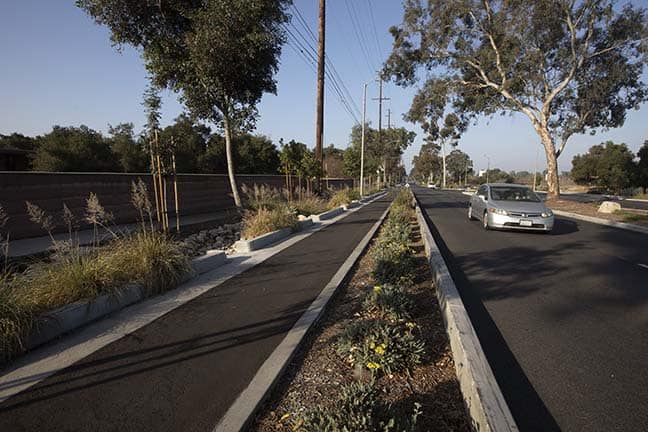At halfway point, city on track to retain balanced budget

The mid fiscal year budget for the City of Claremont was adjusted due to revenues not reported in June including money from the State’s “gas tax” for the improvements to the Foothill Boulevard corridor. City Manager Adam Pirrie told the city council on Tuesday that all of his staff’s projections show the budget will remain balanced through the end of the fiscal year in June. COURIER photo/Steven Felschundneff
by Steven Felschundneff | steven@claremont-courier.com
Throughout the pandemic journey, Claremont’s finance department has sought to maintain a tight ship with conservative budgets, which have at times been aided by higher than expected revenues. This trend seems to be holding as Claremont City Manager Adam Pirrie presented the mid-year budget report this week, demonstrating that the city is on track to meet its financial projections adopted last June.
“Through the midpoint of the 2021-22 fiscal year, the city has received sufficient revenues to suggest that full-year budgetary estimates are realistic, and that the city is on track to meet or exceed those full-year projections,” Pirrie said in his staff report.
The city’s finance staff is confident that expenditures are generally in line with its projections and that expenses will remain within budgetary constraints for the remainder of the fiscal year.
“We did manage to include in the 21-22 budget two items that had not been in prior year budgets, the first was an additional pension contribution that is a discretionary payment to CalPers, and a reserve contribution that is planned for the end of this fiscal year,” Pirrie said.
Through December 31, $32,780,730 of revenue and transfers in had been received, about 56.4% of the adjusted revenue budget of $58,111,583 spread across a number of fund categories. This figure was amended up from about $54 million projected in June.
This figure is higher than typical for the first half of the fiscal year and includes sources of revenue not reported in the budget adopted by city council. Specifically, the receipt of $4.3 million from the American Rescue Plan Act, $2.1 million in grant reimbursements from the state “gas tax” for the refurbishment of Foothill Boulevard and $6.4 million of proceeds from a debt issuance to fund Trane energy efficiency projects currently being implemented by community services.
“We are a bit ahead of where we would normally be but there isn’t any information that we have at this point that indicates we won’t meet any of our budgetary estimates for the full year,” Pirrie said.
For the general fund, which represents the day-to-day operations of the city, revenues and transfers in for the full fiscal year remains unchanged at $28,387,628, of which the city has received $9,957,116, or 35.1% as of December 31 which is fairly uniform as the city typically collects about a third of revenues by New Year’s Day.
“Some of our largest sources of revenue are either paid a month in arrears or are received in the latter part of the fiscal year. Property tax being a prime example. Our largest remittances don’t start until Dcember and January and then continue through August,” Pirrie said.
Sales tax is just over $2.5 million, about $580,000 higher than last year due to a significant increase in online sales which the city collects as its portion of the Los Angeles County pool of this revenue. In addition, automobile sales have remained strong.
“Staff expects revenues from sales tax to exceed estimates and help offset additional unanticipated costs such as those from the 2022 windstorm,” according to the city’s report.
Total expenditures and transfers out to other funds in the original budget amounted to $56,272,366, however, the new projection is quite a bit higher at $69,701,807. The difference reflects “those expenditures related to capital projects, grant awards, carryover of funds for projects that were completed in the prior fiscal year as well as the Trane energy efficiency project that was approved by the city council,” according to Pirrie.
The total projected general fund expenditures, those funds which the city uses to maintain the services residents depend on, had an adjusted annual budget of $28,278,931 of which $13,993,310, or 49.48% has been spent midway through the budget cycle.
The January 21 windstorm caused significant damage citywide, including hundreds of downed trees, broken and displaced sidewalks, overtime costs for staff and the outlays for contract work.
“The cost of that windstorm is going to be significant and we are working on developing some estimates of what those costs are going to be. We have incurred significant costs already in the immediate response to the windstorm,” he said.
“That response cost is likely to be in the hundreds of thousands of dollars, far exceeding anything we would have budgeted for routine tree removal that we would do on an annual basis,” he added.
Pirrie said his office plans to bring a proposal to the council at a future meeting to discuss the financial impacts of the windstorm in order to get some additional funding to address those response costs.
It’s likely that funding will come from the city’s emergency reserves, at least in the short run. Pirrie and the city council declared a state of emergency following the storm, which is the first step in getting reimbursement from the California Office of Emergency Services. However, during the meeting he said that even though Claremont and other cities were hit hard, the collective damages may not reach the minimum amount for a CalOES bail out.
“At this point it’s likely we will recommend the use of emergency reserves to support the costs of storm response, we are fortunate that the current budget includes a reserve contribution of half a million dollars that will also help to offset some of these unanticipated costs. And as I mentioned, sales tax revenues may also provide the opportunity to either fund some of the storm response cost or to help replenish the emergency reserve,” Pirrie said.









0 Comments